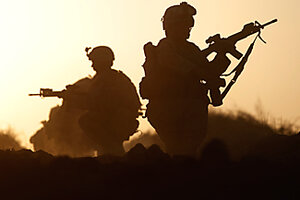McChrystal planned to move soldiers killed in Afghan siege
Insurgents killed eight US soldiers at a remote outpost Sunday. Part of Gen. Stanley McChrystal's new strategy for Afghanistan includes moving soldiers to population centers.

During a firefight with Taliban militants, US Marines take cover, in Nawa district, Helmand province, southern Afghanistan on Friday.
Brennan Linsley / AP
One fundamental tenet of Gen. Stanley McChrystal's controversial Afghanistan strategy aims at avoiding precisely the kinds of attacks that killed eight American soldiers Sunday.
In what is being described as one of the boldest attacks of the Afghan insurgency, an estimated 300 militants sustained a day-long siege against a coalition outpost in Nuristan Province – a place where the rule of law is so tenuous and the terrain so forbidding that it is seen as one of the likeliest hiding places for Osama bin Laden.
It also has fewer people than Cedar Rapids, Iowa.
Beyond the request for more resources that has engrossed America, McChrystal's battlefield assessment proposes deploying American troops in a profoundly different way.
Rather than sending them to the farthest-flung corners of a far-flung nation to hunt down scores of militants hiding in remote mountain caves, it intends to protect the Afghan population first, giving the most Afghans the greatest opportunity of establishing something approaching a safe and normal life.
Fourth of McChrystal's "four fundamental pillars" for a new strategy is: "prioritize available resources to those critical areas where the population is most threatened."
In fact, the very troops in Nuristan forced to fight off unseen attackers firing down from ridge lines cloaked in inclement weather Sunday are poised to be redeployed under McChrystal's new leadership, according to the Washington Post.
The change in course does not promise fewer casualties. Rather, it intends to focus US soldiers on areas where their sacrifices can potentially lead to longer-term security gains.
It is a strategy with inherent risk. Focusing on population centers means, to some degree, giving up rural areas – something McChrystal acknowledged to The Los Angeles Times:
" 'Practically speaking, there are areas that are controlled by Taliban forces,' he said. Over time, McChrystal said, the command would 'reduce' those areas, but the first priority will to be to make sure populated areas are free of insurgent influence."
The strategy of protecting the cities and ceding the rural areas is reminiscent of the failed Soviet strategy of the 1980s. As many as three-quarters of Afghans live in rural areas, according to a 2003 estimate. Yet in an interview with ABC, former Pakistani President Pervez Musharraf suggested that the US experience might be different because "the whole world" – including the US – was funding the anti-Soviet mujahideen.
Moreover, it is in remote areas that the Taliban and other insurgents – like the Hizb-i-Islami militants suspected of carrying out Sunday's attack – have achieved their greatest military successes.
• In what was previously the most notorious battle of the Afghan war, insurgents briefly breached the outer defenses of a US outpost in Wanat – also in Nuristan – before being driven back by air support. Nine soldiers died in the July 13, 2008, attack, prompting a series of Pentagon investigations into why the outpost nearly fell.
• In August, 2008, Taliban fighters ambushed French special forces in the mountains east of Kabul killing 10 and wounding 21.
• That same month, the insurgents attacked Camp Salerno, one of the largest US bases in eastern Afghanistan, using waves of suicide bombers to try to blast open the base's defensive perimeter.
Even successes in remote areas have been costly – and of dubious importance. The classic counterinsurgency strategy that helped to turn the momentum in Iraq – clear, hold, and build – is not possible in Afghanistan's hinterlands.
For example, the effort to take Barji Matal, an oasis of 500 farmers amid the barren peaks of Nuristan, took two months. When US troops left recently – handing over the base to a local militia – Capt. Albert Bryant told the Times of London:
"I guarantee the Taliban will be back inside a week. If you can't hold the village then what's the point in going in there in the first place?... That's not worth a soldier's life."
Said McChrystal in his assessment:
"In a country as large and complex as Afghanistan, ISAF [NATO's International Security Assistance Force] cannot be strong everywhere.... ISAF will initially focus on critical high-population areas that are contested or controlled by insurgents, not because the enemy is present, but because it is here that the population is threatened by the insurgency."
-----
A new kind of war
The counterinsurgencies in Afghanistan and Iraq represent a redefinition of what war is and what victory means. Click here to read how that could change how American prepares for the threats of the future.
-----
Follow us on Twitter.
